










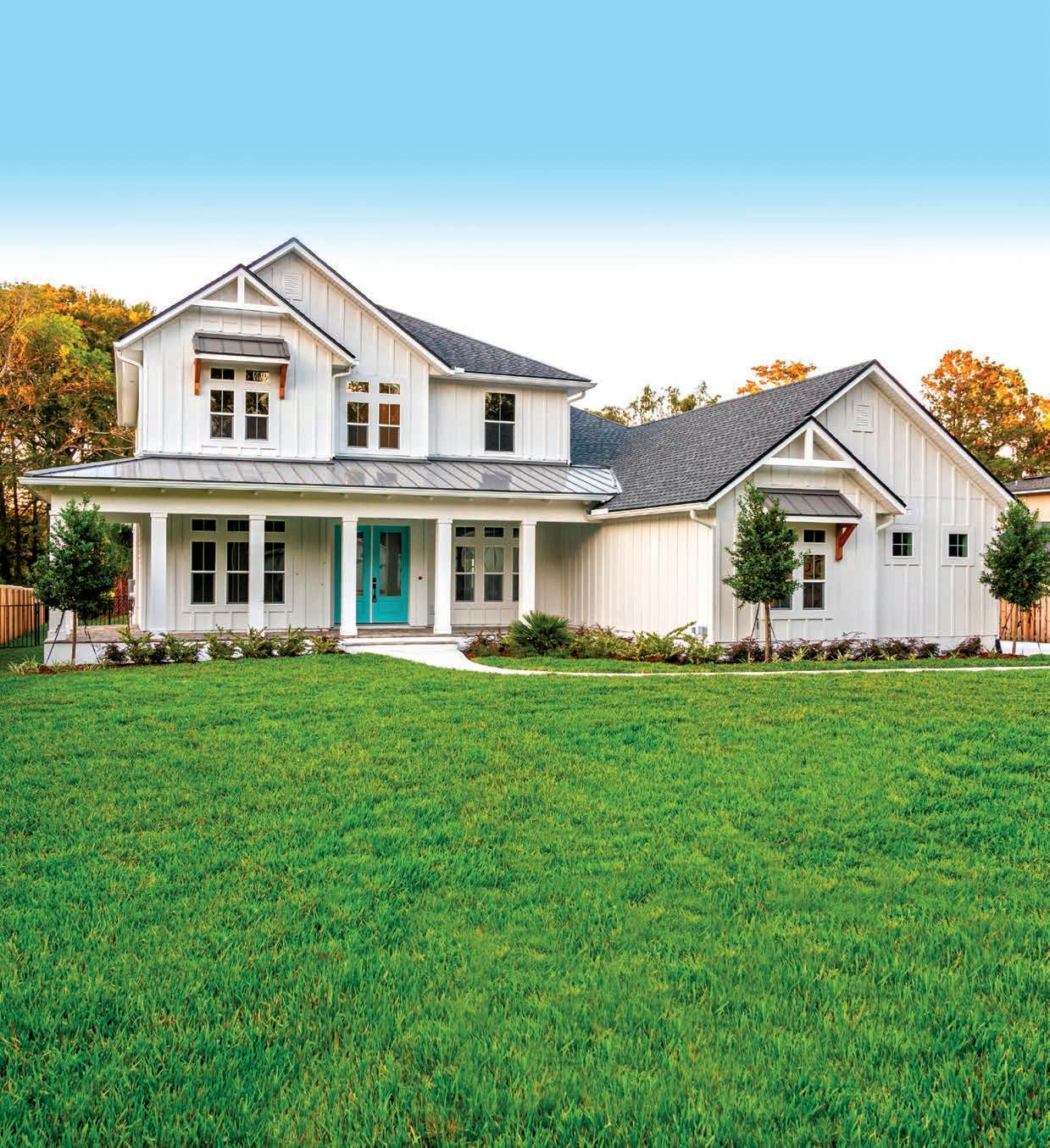
Heating





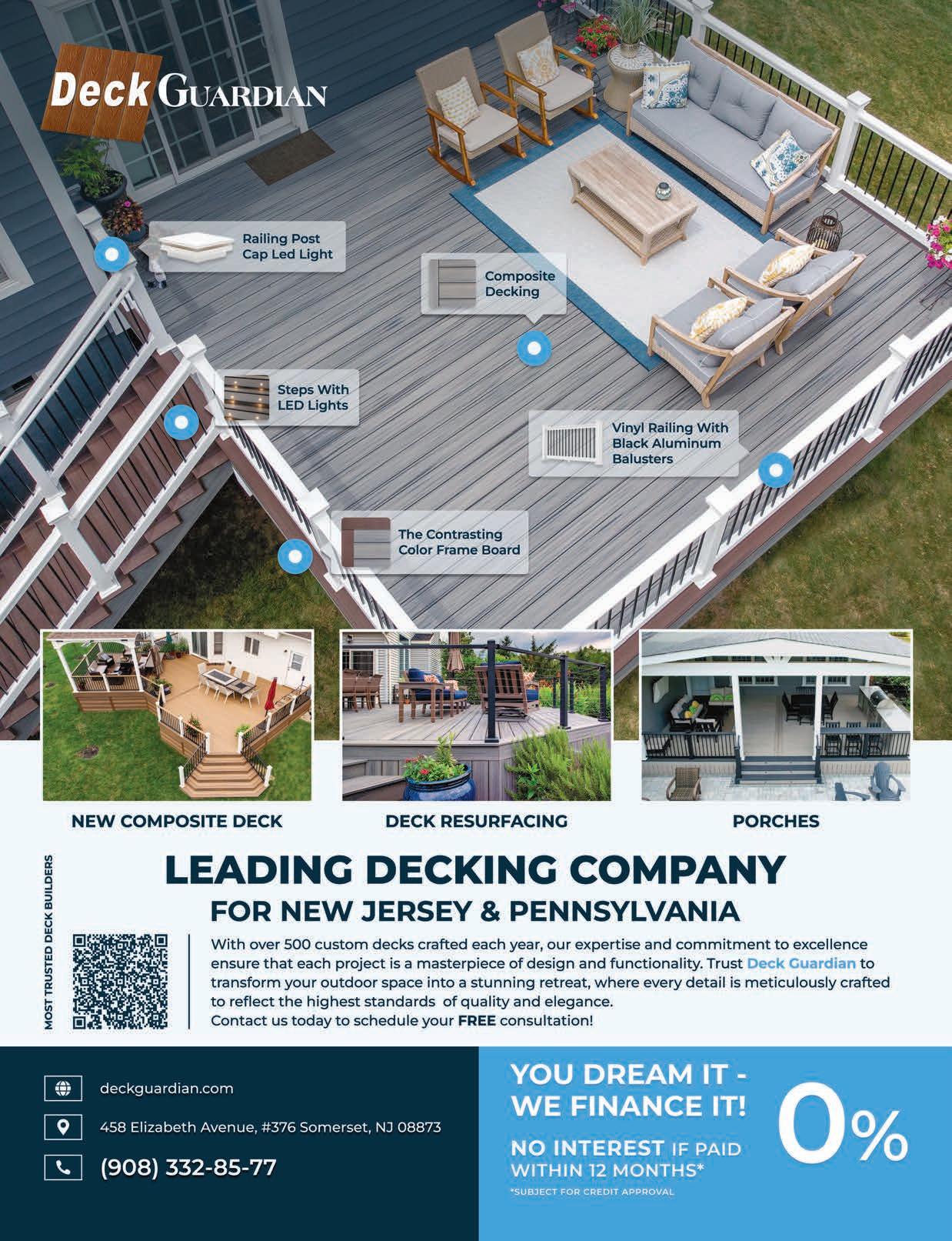




13 Family Values Led by a father-and-son duo, Rosenello’s Windows, Siding & Roofing brings a personalized touch to customer satisfaction
14 Home is Where the “Hearth” Is No matter how you’re staying warm at home, you’ll want to know the best ways to ensure quality, safety and efficiency
26 A Step Ahead Fall’s arrival is the perfect time to start winterizing your home
31 Breaking the Mold Architectural Concrete Design brings unmatched expertise and a designer’s eye to your decorative concrete projects






PUBLISHER
Edward P. McCartney
EDITOR
Peter Proko
ASSISTANT EDITORS
Matt Cosentino, Madeleine Maccar, Carly Murray
CONTRIBUTING WRITERS
Kristen Jorgensen, Chelsea Valcourt
CREATIVE DIRECTOR
Hank Alspach
PRODUCTION MANAGER
Brian Mikulski
DESIGNERS
Alex Bianco, Jay Urbaniak, Lisa Zollinger
ACCOUNTING DIRECTOR
Darlene Versak
SALES DIRECTOR
Lindsay Gonzalez
SALES MANAGER
Jim Romano
NEW BUSINESS DEVELOPER
Chuck McKane
MARKETING CONSULTANTS
Kristine Di Nardo, Rochelle Dodge, Frank Liantonio, Darren Slaughter, Lori Vorgang, Amy B. Weiss
ACCOUNTING MANAGER
Max Haggerty
STAFF ACCOUNTANT
Karmal Pritchett
DIGITAL MEDIA DIRECTOR
Leigh Stuart
PUBLISHER EMERITUS
Bob Doran
EXECUTIVE PARTNERS
Gerry Haggerty, Edward P. McCartney
HOUSE & HOME Magazine, LLC, dba HOUSE & HOME (“H&H”). H&H reserves the right to determine the suitability of all materials submitted for publication and to edit all submitted materials for clarity and space. H&H is not responsible for loss, damage or any other injury to unsolicited manuscripts, unsolicited artwork or any other unsolicited materials. Furthermore, H&H will assume that unsolicited photographs, as well as ad photographs, are being submitted for possible publication and should they be published, no fee is due the photographer or model unless otherwise agreed upon in advance in writing. HOUSE & HOME is a news magazine with emphasis on home repair and remodeling. H&H does not knowingly accept false or misleading advertising or editorial content, nor does H&H or its staff, editors or writers assume responsibility should such advertising or editorial content appear in any publications. Readers are encouraged to notify H&H if they suspect false or misleading advertising.
Before attempting any renovation or repair project mentioned in H&H, readers are advised to consult with professional home repair and renovation specialists for assistance, and to take any and all appropriate safety precautions.
HOUSE & HOME has not independently tested any products or services advertised herein and has verified no claims made by its advertisers regarding those services or products. HOUSE & HOME. makes no warranties or representations and assumes no liability for any claims regarding those services or products or claims made by advertisers regarding such products or services. Readers are advised to consult with the advertiser and/or other home repair and renovation professionals regarding any such claims and regarding the suitability of an advertiser’s products. No reproduction of printed materials is permitted without the consent of the publisher of HOUSE & HOME. Copyright 2012 by HOUSE & HOME. Magazine, LLC, all rights reserved. Subscription available for home delivery at our website, www.HouseMagazine.com, at a cost of $19.95 per year.










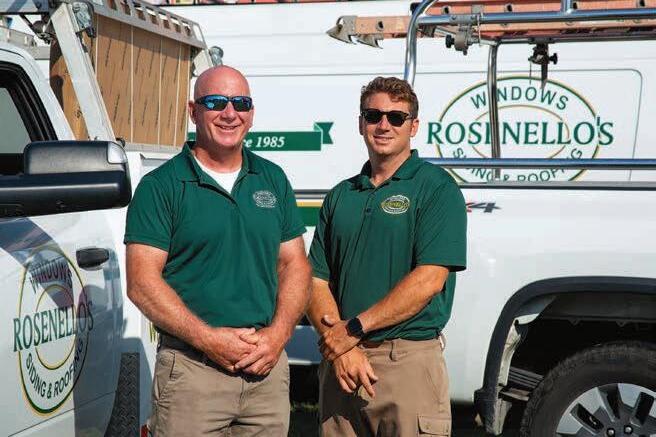

Led
Mike Rosenello has witnessed quite a few changes in the nearly four decades since he started owning and operating Rosenello’s Windows, Siding & Roofing. From technological advancements to the evolution of product materials, the home-improvement industry has taken many dramatic steps forward. While most of those changes have been in the name of progress, Rosenello has found one particular trend to be rather alarming: Family-operated businesses like his are becoming a rare breed.
“A lot of family-owned companies are being bought up by large corporations, and there’s a major difference between corporate culture and family culture,” he says. “Not only do they charge two or three times the value of a job, but there’s no personal touch. When you call a big company, the previous person you spoke to might have left months ago, and the person you’re talking to now has no idea about your project. That’s never the case with us. We build longstanding relationships with both employees and customers.”
Family is of the utmost importance to Mike, a father of five and grandfather of eight, with a ninth on the way. He is thrilled to have several family members as part of the company, which celebrates its 40-year anniversary later this year. Mike’s son Eric, for example, has assumed a leadership position and is eager to help move the business forward.
Although he grew up around the business, Eric never envisioned running it one day. He has found his career choice quite rewarding, with the opportunity to put his marketing and management degree to good use on a daily basis. In addition, he’s pleased to see the trades becoming a more attractive career path, though he believes fields such as his can always use more resourceful and hardworking people.
“I realized it was a good line of work to pursue and [appreciated] the opportunity that was created for me,” he says. “I didn’t want to see the business change hands; I wanted to keep it as a Rosenello family business and grow the brand.
Eric learned from his father the cornerstone values upon which Rosenello’s was founded—namely, treating customers with respect, and always being upfront and honest.
“I’ve learned about treating people right,” he adds. “A lot of homeowners have horror stories with contractors, so we want to provide the type of service that we know can be provided in this industry. We’ve seen how other companies do things, and we think we’re able to do it much better.”
Mike focused solely on roofing when he first started the company, offering the best lifetime shingles and roofing products in the industry from manufacturers like GAF. Roofing
remains a core part of the business, though the company’s menu of services has grown to include siding and replacement windows. Whether customers are seeking curb appeal, energy efficiency, or better functionality—or a combination of all three—Rosenello’s installs durable, aesthetic options from leading brands such as Andersen, OKNA, Pella, and ProVia.
Many customers choose to have windows and siding done at the same time. Rosenello’s offers vinyl siding from CertainTeed and James Hardie fiber cement siding. No matter which town a customer calls home or which services they need to enhance the value, visual appeal, and energy efficiency of their home, Mike says they can count on a positive experience with Rosenello’s. Employees never pressure a homeowner to buy a particular product or service, and when team is hired for a project, they promise treat the home as if it were their own.

“Our customers love our employees,” Eric says, adding that many employees have been with the company for decades. “We get phone calls, text messages, and emails all the time about how nice the employees are. If it’s an older customer who needs help with something else that doesn’t involve the project, they’ll take care of it while they’re there. Small stuff like that makes a difference, and it definitely feels good when you get those calls or messages about the employees going above and beyond. If you treat your employees well, they’ll treat the customers well.”
For the man who founded Rosenello’s nearly 40 years ago, he believes the quality of his people represent the biggest difference between his company and his competitors.
“Our slogan used to be, ‘Unequaled products, price, and professionalism,’ and I still really believe that,” Mike says. “A lot of people have good windows, but their service isn’t as good; they forget about you a few years down the line. Then there are those who will give good service, but they charge so much for the windows.
“We try to provide a combination of all three,” he continues. “Our pricing is very good compared to the bigger companies, and you can see our professionalism in the way we get back to everyone immediately through calls, texts, or emails. We’re a family business, and we want to keep our name correct.”


























Whether you’re opting to stay warm with a heating system or a fireplace this winter, local professionals weigh in on the aspects to look for to ensure quality, safety and efficiency.

Ahome heating system is not typically at the forefront of peoples’ minds, especially before the onset of winter. If there is any kind of problem with a heating system, it is usually only realized when it’s turned on in the winter when heat circulation is most necessary. However, if a heating system has run its course or if a homeowner is just looking for a change, there are plenty of different options available that best suit the lifestyles within each household.
“Addressing your home through your insulation, your ventilation and mechanicals truly benefits everything that is essential to someone, and being able to be attentive to that with seasonal maintenance ensures the best quality of life for your loved ones and the essential belongings in your home,” Allied Experts’ Director Jose Diaz affirms.
The first step is to assess a home’s heating system with the help of a professional to check if any regular maintenance is needed. These often-neglected checkups can save time and money before an easily-fixed issue turns into a bigger problem.
“The biggest thing is getting your maintenance, and tune-ups in general, done by a qualified professional, who will come out and change the filter, take a look at the heating system in general and make sure that it’s working at peak efficiency for the next season,” says Jeff Olewine, general manager of C&C Heating and Air Conditioning.
Olewine recommends having biannual inspections: one in spring and one in fall. Even getting started in August through September is better than nothing. Often a lack of general maintenance is the common culprit of issues with home heating systems.
“The most common issues revolve around the blower assembly in the furnace or a dirty air filter. Air filters are often forgotten about,” says John Laphen, service manager with Doylestown Air.
Every circumstance is different, so having a professional check the system before it is fired up—especially after not
using it for several months—is always safest. A neglected heating system doesn’t necessarily indicate danger, but it’s always best to prepare for and to have a plan for the unexpected.
“The biggest [safety] concern would be being without heat during a cold snap. Another potential risk is the heat exchanger cracking, which can allow carbon monoxide to be released,” Laphen continues.
An unexpected broken system—especially during the holidays when spending is maximized—may leave household occupants shivering in what is supposed to be the comfort of their homes until they can find the time availability and funding. In such an urgent situation, it may be difficult to properly assess the next steps, but each situation has a different, more cost-efficient option.
“If someone’s looking to replace their system, typically it’s when they have a certain amount of issues with a unit that needs repairs and it doesn’t make sense to put money into repairing it,” says Olewine. If efficiency, sustainability and cutting costs are of interest, a newer model might be the best solution. Companies like Allied Experts offer innovative products that are easier to manage while being kind to the
environment. The best option for each home can be determined with full home evaluations. In addition to working to assess the needs of your home, an experienced professional may also help cut down on costs as they are knowledgeable of financing options within the industry.
“There are beneficial tax breaks that customers should be made aware of with the Inflation Reduction Act. Utility programs and the Department of Energy [within the] federal government are going to be very active in pursuing options to help with energy efficiency and savings in the home. Homeowners should be aware that they have options for assistance,” Diaz explains.
Beyond accessibility to cost-saving and government assistance programs, upgrading your system increases efficiency of your home, in turn lowering your heating bill.
Smart home models have heightened connectivity to other devices and are designed to provide a higher performance quality and energy efficiency. These electric “smart” heaters can connect to WiFi and can be controlled through phone and voice apps, some have room sensors to optimize usage and allow for programmable cycles.
Compared to home heating systems, fireplaces are more geared toward enjoyment, providing heat to only those nearby. Undoubtedly, a burning fire creates a picturesque holiday atmosphere.
“It’s more fun than beneficial, because 80% of people are using fireplaces to heat the room a little bit and also to enjoy the fire, smell and noise of the wood when it burns,” says Ardian Bejita, owner of Doctor Chimney.

Burning wood requires a supply and it’s best to have experience or practice. It is not as cost-effective or sustainable to use wood compared to gas or electricity. Although wood-burning fireplaces are harmonious with nostalgia, they too have seen a technological upgrade with dozens of choices.
“First-time buyers really need to consider their lifestyle and their time commitment,” Chris Olsen, owner of Newtown Fireplace Shop describes. “Are they looking for ease and convenience, or do they really love the smell and the natural crackle of real wood? Do they have the time to burn, to stack and store wood, or are they going to find more value in having ease with the use of a remote control for gas?”
Olsen and his team strive to customize the aesthetic of new fireplaces to fit the style of each home. Many of the Colonialand farmhouse-style homes in the New Jersey, Pennsylvania and Delaware regions are already equipped with built-in fireplaces. However, these still need to undergo some considerations before they are used.
“Homes that were built any time before 2010 have a very high chance of having a negative efficiency appliance and solvent, meaning customers don’t even realize that it’s taking the heat out of their home rather than adding heat value to the home,” says Dave Rettinger Jr., owner of Rettinger Fireplace Systems. “And when it’s not used, it’s just a big hole for cold air to pour into the house. So, we have products that solve that exact problem that many thousands of homeowners, either knowingly or unknowingly, are challenged by today.”
Fireplace inserts can help with efficiency and are a great way to upgrade a decadesold, wood-burning fireplace to a safer and more energy efficient option. They will convert an existing fireplace opening to wood, gas or electric and will still release smoke through the chimney. If using a fireplace this winter, one should assess the system itself and the chimney.
“People need to inspect the chimney smoke chamber and the lining. So, they need to go in the house, take a look if there are any cracks, any holes, any missing lining—that’s very important,” advises Bejita. Chimneys need to be cleaned and inspected before fireplace use. Chimney liners reduce utility costs, streamline maintenance and cleaning, and allow for more safety. Depending on home- and township-specific codes, different types of liner may be installed, often depending on the type of fireplace and the size of the chimney flue. Liners can be made of stainless steel, high thermal re-




sistance ceramic, clay or aluminum.
Due to all of the necessary aspects that go into a fireplace system that may have to be divided among multiple specialists, some companies will act as a one-stop shop to fully guide a customer through the multifaceted process. Chimney sweeping is required for any system update, which Rettinger Fireplace Systems provides in conjunction with its concierge service.
“If we need a licensed electrician or plumber on the job, we’ll hire them for you. If you need permits and inspections, which almost all jobs do, we’ll take care of the permits, we’ll arrange for the inspections,”
says Rettinger. “You cannot do anything to an existing fireplace without getting a Level 2 inspection.”
The wide range of product options available for heating a home today allow for different types of operation, effect and maintenance. Ultimately, though, warmth in the home is primarily about comfort.
“Homeowners should really take a look at their fireplace to make sure that it’s creating an inviting, warm environment that makes their house feel like a home,” says Olsen. “Is it providing the ambiance, the atmosphere, the look, the style that fits their energy? They are creating that mindset to make a peaceful home.”

Allied Experts Cherry Hill, N.J. (856) 210-8824 AlliedExperts.com
C&C Heating and Air Conditioning Souderton, Pa. (215) 799-0515 CC-HVAC.com
Doctor Chimney Emerson, N.J. (201) 981-8382 DoctorChimney.com

Doylestown Air Pipersville, Pa. 215-598-7494
DoylestownAir.com
Newtown Fireplace Shop Newtown, Pa. (215) 968-3981
NewtownFireplaceShop.com
Rettinger Fireplace Systems
Voorhees, N.J. (856) 317-6490
RettingerFireplace.com









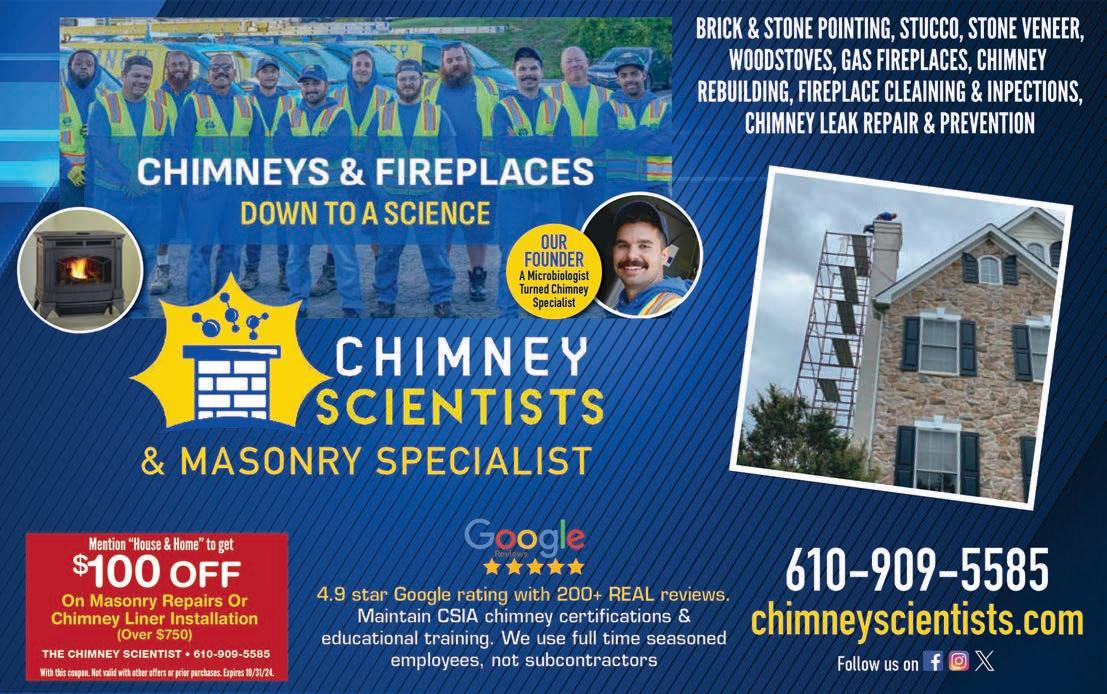
Fall is the perfect time to begin winterizing your home.
BY PETER PROKO
With autumn’s arrival, countless homeowners are looking forward to admiring the fall foliage and enjoying extended outdoor activities whether around the fire pit, the pumpkin patch or otherwise.
But the fall season also creates a great opportunity to get one’s home ready to handle the harsher conditions that Old Man Winter brings. Winterizing your home should be top of mind for all homeowners, as it can solve problems in the short-term while also saving you lots of time, money and aggravation in the long term.
Adam Parnes of Global Home Improvement acknowledges the importance of staying on top of a winter checklist and says that homeowners who don’t regularly do so are tempting fate. “I think anyone who is winterizing their home is already ahead of the ball game,” he says. “Upgrading insulation, re-caulking windows and cleaning gutters are some of the easier solutions to a safe home this winter.”
House & Home spoke with various leaders in the home improvement industry to get a better understanding of the key areas to focus on when winterizing your residence. Whether making energy-efficient upgrades to the interior or making necessary repairs to the exterior that also help boost curb appeal, the fall season offers ample opportunity to rectify any issues now and give homeowners some reassurance for once winter arrives.


Checking to see if one’s HVAC system is in need of a tune-up is recommended by industry professionals. Annual service will ensure things are running smoothly and curtail rising energy bills that result from suboptimal operation.
Poorly insulated attic space can also be a major contributor to energy loss. According to the Department of Energy, a properly insulated attic can help slash you heating bill as much as 50%.
Another common contributor to energy loss is poorly sealed windows and doors. “Not only do older windows and doors not have updated thermal efficiency, but many of them have air leaks, which are just inviting cold air directly into your home,” says Parnes.





Brian Iwano, founder and project manager with Blue Tree Builders, says it can be difficult for most people to tell if it’s time to replace their windows if there’s no clear and present physical damage.
“The obvious signs your windows need replacing are when the seal fails and air gets between the panes; and with older wood windows, when the wood becomes damaged. Aside from these examples, it can be difficult to notice air seepage during mild weather,” he says.
Replacing one’s roof or siding can be a sizable expense and cause some homeowners to delay any major repairs or replacements for another season in hopes they can avoid any catastrophic issues while saving some money. But one major winter storm can change that equation and the result could be an even heftier out-of-pocket cost.



When looking to determine if your roof may be a candidate for either repair or replacement, one tell-tale sign is the appearance of leaks. But there are also other factors to consider, namely age. Is the roof 20-25 years old? If so, it’s likely the shingles have or will soon start to curl and the adhesion to one another will become compromised.
“The most important thing to consider is what could happen if you don’t replace it,” says Parnes. “A leaky roof will cost you way more money in damage then the money you save by trying to wait one more year.”
“This may seem obvious, but look for any damage that may have occurred from summer storms,” adds Iwano. “It’s pretty easy to look for missing shingles. This in itself isn’t all bad, as the real waterproofing is maintained by the underlayments and other prep. However, missing shingles do leave your roof open to further wind damage, which would definitely cause bigger problems very quickly.”
Danny Cenaj of Siar Construction says in addition to seeing missing or buckled shingles that are no longer lying flat, there are other noticeable changes you may recognize. “If one area is much darker than another part of the roof; that is one of the other signs that it may be time to get a roof inspection. Another thing would be if you are cleaning your gutters and you are able to see a lot of granules that have fallen from the shingles,” he says.
If your roof is old or you are not sure it will last another winter, fall is actually the ideal time to have it replaced. In the summer when battling extreme heat and humidity, the shingles can occasionally become damaged during the installation process, something that is certainly avoidable thanks to fall’s cooler temperatures.
“The fall is one of the best times of the year to replace the roof,” affirms Cenaj. “Homeowners can make sure they get everything done right before winter, which gives them peace of mind that they will not have to contend with any issues.”
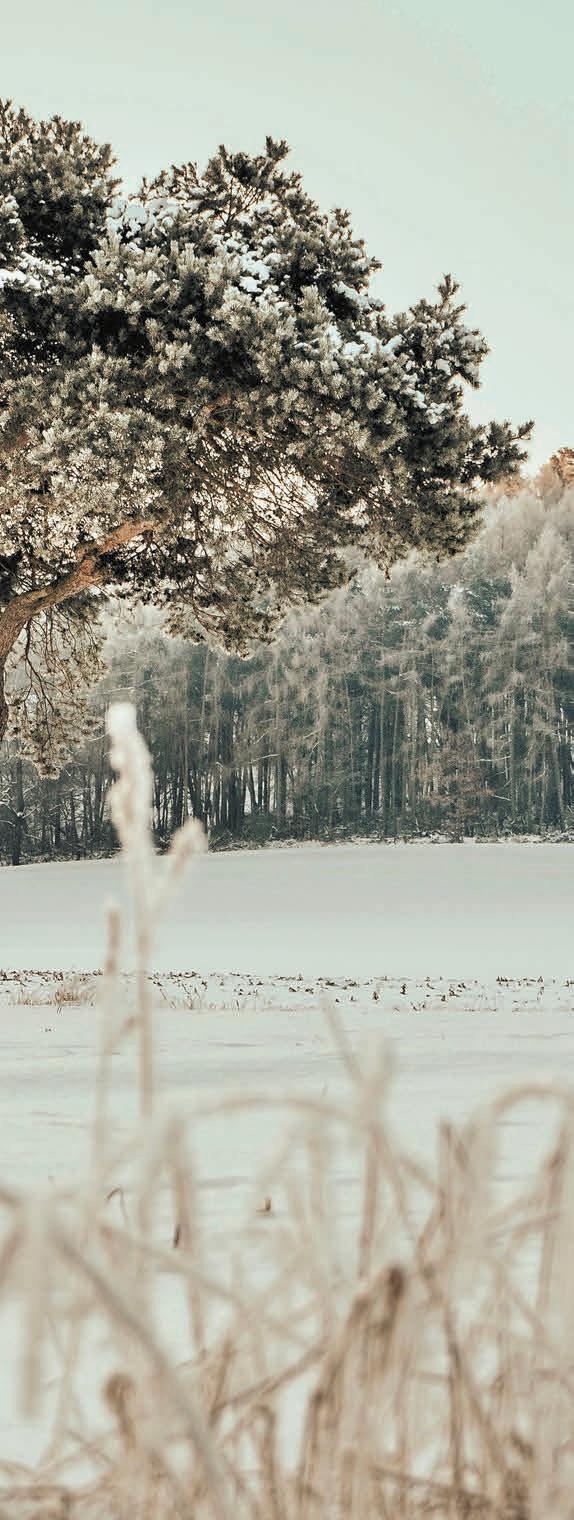
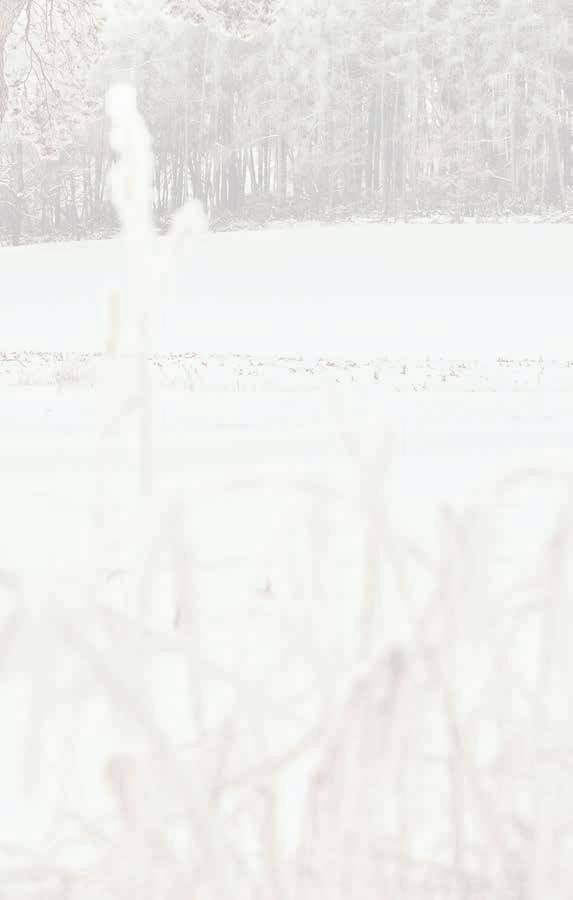

Elsewhere on the exterior, Iwano points out that problems with siding usually occur at transition points either between trims or moldings, or aluminum capping. “Additionally, end pieces and tops commonly become loose, which also [could lead] to further wind damage. Again, like roofing, the real protection is in the prep. But you definitely want to mitigate any vulnerability as soon as possible,” he says.
For those who enjoy lighting a fire inside the home during the winter months, fall is also the right time to have your chimney serviced, as a detailed inspection can help to uncover any potential hidden issues. “Inspections will check for any cracks in the cement or the mortar or if there are any other problems, and you will be able to determine if the chimney will be good for the winter or not,” says Cenaj. At the very minimum, Cenja advises

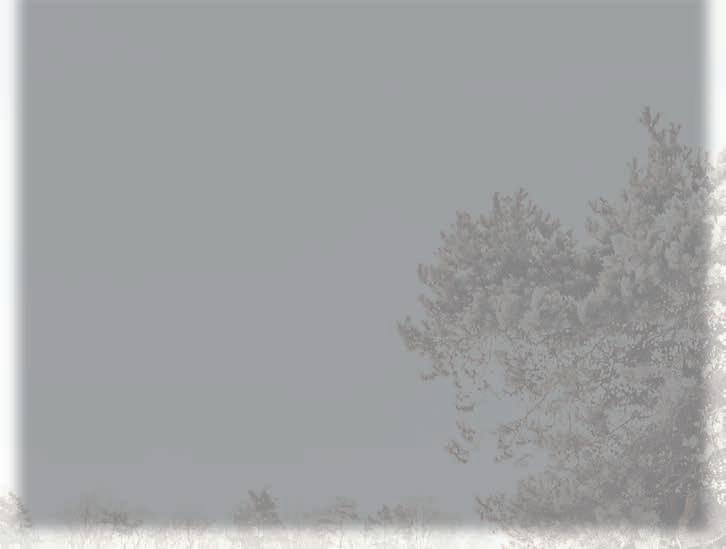
homeowners to have their chimneys cleaned before seasonal use. “Getting a chimney cleaned is something I would say is mandatory every fall before you start using your fireplace,” he says.
It’s important to know how to winterize a pond and prepare fish to withstand the
harsh winter. Over a year, your pond will accumulate debris and organics such as leaves, twigs, grass clippings and fish waste. Left unchecked, decaying debris can release toxic gas and reduce oxygen levels. Removing this debris and replacing filtration systems with aeration kits and deicers will help ensure oxygen levels stay as high as possible and provide aeration,





ventilation and circulation throughout the winter months.
“When fall officially arrives, and the trees start losing their leaves, we often recommend netting your pond,” says George Mihalchick of Ponds by George.
Fall netting is intended for collecting debris, and is often a choice to use for predator protection, which is why some pond owners even choose to leave the net in place until spring, but it is important to note that these nets are not de-
signed to carry a heavy snow load, and should be removed in the winter before any snowfall.
“Once all the leaves have fallen, begin your fall pond care by removing any netting. Pond netting should be stored indoors to keep it safe from wear and tear due to heavy snowfall and ice,” says Mihalchick.
As fall ends and winter approaches, plants will naturally fall into a dormant state. To winterize hardy plants, use
your pruning tools to trim off dead foliage just above the soil. Removing debris that may have made it into the pond should also be removed.
“Rotting leaves, twigs or dead aquatic plants will put stress on your pond’s oxygen levels throughout the winter, which puts your fish at risk. I recommend removing leaves and debris from ponds and streams with the help of a hand net if possible,” Mihalchick details.
Another way to keep fish safe when temperatures drop is with the help of aeration, and de-icers help to keep a hole open in the ice during winter months. “This prevents harmful gases from being trapped under the ice and allows oxygen levels to stay saturated in the pond. Or if your pond has a waterfall, leave it running, the movement will cause a natural opening,” Mihalchick explains.

Blue Tree Builders Cherry Hill, N.J. (609) 240-3231
ExperienceBlueTree.com
Global Home Improvement Serving Pa. and N.J. (888) 234-2929
GlobalHomeInc.com
Ponds by George Southampton, Pa. (215) 396-7500
PondsByGeorge.com
Siar Construction Garfield, N.J. (973) 964-1777
SiarConstructionNJ.com


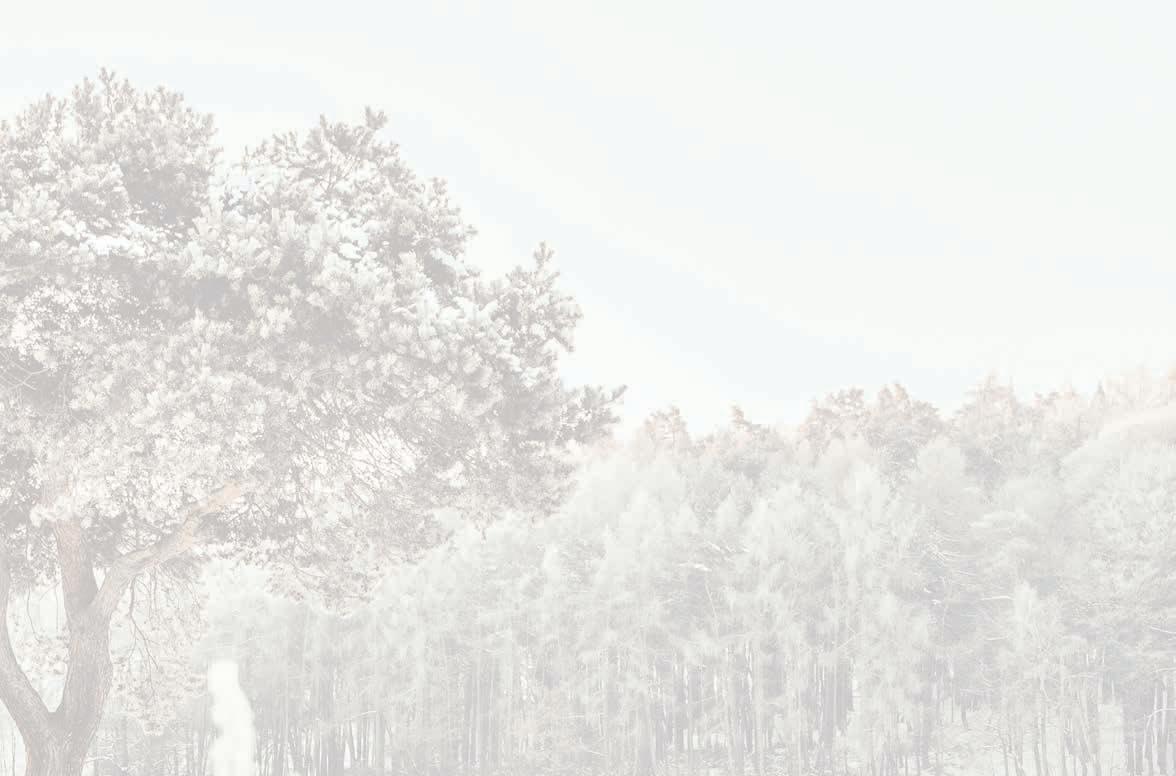



profile by Kristen Dowd



“Our approach is meticulous, ensuring the use of superior materials, adherence to optimal curing times and deployment of skilled crews,” Abel says. “This dedication to quality, coupled with our 30-year legacy as both a residential and commercial contractor, has cemented our reputation among the region’s top builders.”

Abel says ACD’s philosophy is encapsulated in its motto: “We only have one chance to be perfect, do it right, do it now, whatever it takes.” This sentiment is a reflection of the company’s commitment to excellence, which it achieves by ensuring top-tier talent, the finest materials and best-practice installation methods.



IN THE EARLY ’90S, DECORATIVE CONCRETE WAS A LITTLE-KNOWN ARCHITECTURAL ELEMENT ON THE EAST COAST.
That all started to change when Architectural Concrete Design, or ACD, came onto the scene in 1993. When founder Chris McMahon started the Levittown-based business, his aim was to introduce the Greater Philadelphia area to the innovative world of decorative concrete.
“Our foundation was built on the principle of blending aesthetics with functionality in concrete designs,” ACD’s Managing Partner Steve Abel says. “This innovation rapidly positioned ACD as the leading decorative concrete installer on the East Coast. Our journey of innovation continued as we developed custom stamping tools, contributed to industry-standard application techniques, and consistently delivered unparalleled installation quality.”
He continues, “What truly sets ACD apart is our unwavering commitment to decorative concrete. Unlike many in the field who might dabble in various construction areas, we focus solely on this specialty. Our team, led by foremen with over 25 years of


experience, understands the art and science of decorative concrete.”
From its location on New Falls Road, ACD specializes in a variety of decorative concrete solutions: stamped concrete, which can replicate stones, tiles or bricks; exposed aggregate, which creates a textured surface by exposing rocks, pebbles, sand or other material mixed in with the concrete; and colored concrete, which comes in a wide selection of shades. The company also offers comprehensive maintenance services for clients’ existing concrete structures.
Decorative concrete is a longer-lasting, easier-to-maintain product that is also more cost-effective than traditional materials. The design options are seemingly endless, too, with sophisticated styles and trendy finishes—or even the chance to create something completely outside the box.
ACD can install its products wherever a client is looking to improve aesthetics and functionality around their property, too. This includes pool decks, driveways, patios, walkways and more. The company strives to showcase its expertise and excellence in every project, whether it’s a commercial job or residential property.
“Our customer-first mentality is at the heart of our operations. We understand the challenges of transforming raw materials into artistic products under time constraints, and we thrive in this demanding yet rewarding environment,” Abel says.
ACD is ready to meet the needs of every client, whether it’s a seasoned professional with precise requirements for the project they’re envisioning or a brand-new customer who wants to find out how stamped concrete can transform their home.
“We tailor our approach to each client’s needs,” Abel says. “Our design team plays a pivotal role in this process, helping clients understand the product, market trends, and how these align with their personal preferences and functional needs.”
Collaborating in this way ensures a customized project that is going to please the client, according to Abel.
And becoming an ACD client is as easy as giving the office a call or submitting an inquiry through the company website.
“We welcome everyone, from homeowners exploring decorative concrete options to ready-to-proceed customers,” Abel says. “Our team is passionate about what we do and eager to assist clients in making informed decisions.”




